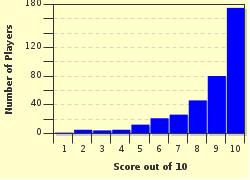Quiz Answer Key and Fun Facts
1. Every bowler wants to see one of the bails (even better, one of the stumps) flying through the air after the ball has been delivered, without involving the assistance of any other members of the fielding team. In what way is the batter described as being dismissed when this occurs?
2. One of the most common modes of dismissal for a batsman in cricket is to have hit the ball into the air, and have it caught by a fielder before it hits the ground. When this happens, how is the batsman said to have been dismissed?
3. The batsman in cricket attempts to keep the ball from hitting the wicket in front of which he is standing. If he uses his body (usually the protective pads on his legs) rather than his bat to do this, he may be judged out in what way?
4. A batsman may be declared "run out" if a member of the fielding team dislodges a bail with the ball while the batsman is out of his ground. Which of the two batsmen on the field at any time can be declared out this way?
5. A batsman is declared out "stumped", because the bails were removed while he was out of his safe ground after moving forward to play a ball which he missed. Which member of the fielding team was responsible for removing the bails?
6. A batsman loses his balance, and his cap falls onto his wicket, causing one of the bails to fall off. Although the fielding team had no responsibility for this, the umpire will declare the batsman out. What mode of dismissal will go on his record?
7. Another unlucky batsman has mis-hit the ball, and it is bouncing around near his feet. He extends his bat to hit the ball further away, and sets off for a run. When the fielding team appeals, how will the umpire rule the batsman out?
8. When players are scrambling for a run, there may be several members of the fielding team in the same area as the two runners. If a batsman deliberately runs between a fielder and the ball, or makes contact with the ball so as to prevent a fielded ball from hitting the stumps, he will be out. What will the record books say beside his name in the scorecard for the match?
9. In a match between Pakistan and Australia, Australian batsman Andrew Hilditch picked up the ball that had been returned from the outfield. He tossed it to the bowler, Sarfraz Nawaz. This unthinking act of courtesy caused his dismissal when the bowler appealed, as he had breached one of the rules of the game. How was he judged to have been dismissed?
10. One of the rarest ways in which a batsman can be judged out in cricket is "timed out". What did the batsman do wrong when he is dismissed "timed out"?
Source: Author
looney_tunes
This quiz was reviewed by FunTrivia editor
Dalgleish before going online.
Any errors found in FunTrivia content are routinely corrected through our feedback system.

